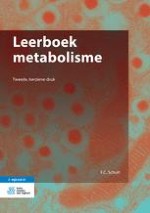Gepubliceerd in:
2015 | OriginalPaper | Hoofdstuk
6. Glycogeenmetabolisme, gluconeogenese en pentosefosfaatweg
Samenvatting
Hoofdstuk 6 begint met de aanmaak en afbraak van glycogeen (respectievelijk glycogeensynthese en glycogenolyse). Glycogeen vertegenwoordigt een beperkte hoeveelheid reservebrandstof in de lever (tussen de maaltijden – bufferen bloedglucoseconcentratie) of in de witte spiervezels (contracties – synthese van ATP). De regeling van beide processen is reciprook en verloopt via reversibele (de)fosforylering van glycogeensynthase en fosforylase. Een reeks erfelijke ziekten van deze wegen leidt tot glycogeenopstapeling (glycogenose). Als we vasten, zal de lever de bloedglucoseconcentratie verder op peil houden via de gluconeogenese, een proces waarin aminozuren, glycerol en lactaat worden omgezet in glucose. De flux van deze weg wordt onderdrukt door fructose-2,6-bisfosfaat. De pentosefosfaatweg begint bij glucose-6-fosfaat, die oxidatief wordt omgezet tot ribulose-5-fosfaat met vorming van NADPH. Uit ribulose-5-fosfaat kan ribose-5-fosfaat ontstaan voor de synthese van RNA en DNA, of glyceraldehyde-3-fosfaat en fructose-6-fosfaat die kunnen dienen voor vetzuursynthese. Veelvuldig voorkomende mutaties in het glucose-6-fosfaatdehydrogenase-gen houden verband met bescherming tegen malaria-infecties.
